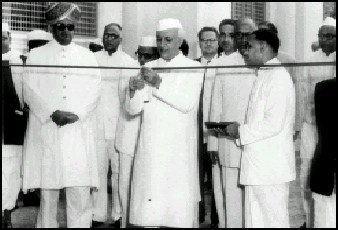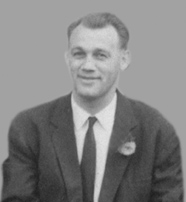1. THE GENESIS
1.1 The inauguration
 Pandit Jawaharlal Nehru inaugurates 16th September 1960 A landmark in the history of anti tuberculosis movement |
The National Tuberculosis Institute (NTI), Bangalore the dream of several concerned and thinking individuals, became a reality on September 16, 1960, at Bangalore. The Prime Minister of India, Pandit Jawaharlal Nehru, reached ‘Avalon’ (the Institute premises) at 8.30 a.m. He was accompanied by His Highness (HH) Jayachamarajendra Wodeyar, Governor of Mysore, Sri BD Jatti, Chief Minister of Mysore and a host of other dignitaries. Awaiting their arrival were Sri DP Karmarkar, Union Health Minister; Dr KK Hegde, Minister of Health, Government of Mysore (GOM); Lt Col V Srinivasan, Director General of Health Services (DGHS); Dr PV Benjamin, Adviser in Tuberculosis (TB), Government of India (GOI); Dr NL Bordia, Director, NTI; Dr C Mani, Director, World Health Organisation/South East Asia Regional Office (WHO/SEARO); Mr TJ Davies, Chief of United Nations International Children’s Emergency Fund (UNICEF) in India; Dr HT Mahler, Senior WHO Medical Officer (MO), staff and invitees. 1
It is difficult to articulate the enthusiasm that pervaded the atmosphere. It was as if the best people had gathered to dedicate themselves to fight the dreaded menace called TB. All the leaders had come in support, with the Prime Minister and Governor of Mysore in the lead. The Indian National Flag fluttered on top of Avalon symbolising that India, through this Institute, would give it a hard try. The entire premises was tastefully decorated for the Inauguration.
On 15th May 1959, the mansion ‘Avalon’ had been taken over by the GOI. Dr Benjamin, the primary force behind this, was perhaps as eager to acquire it, as was HH Jayachamarajendra Wodeyar to relinquish it. There was some delay because Dr Benjamin had to commute from Delhi, nearly three days away by train, in those days. In fact, the first choice had been the Jayamahal Palace and not Avalon. Dr DR Nagpaul the TB Officer in the DGHS in 1958 mentions in his memorabilia: In late 1958, Mr Reuben, Junior Architect in the DGHS and I had been assigned to survey the Jayamahal Palace premises for housing the proposed NTI. We arrived at the site and found the premises all locked up. A brief chat with the person running the petrol station located in a corner of the huge estate revealed that we must not entertain the idea of looking inside the palace premises as it was unused for long. We considered the Jayamahal suitable for the Institute. Especially attractive was the long line of stables, built for race horses which could be used for the large fleet of vehicles. The available accommodation would be appropriate after some modifications. The estate was wooded and attractive for use by an educational institution and there was sufficient area to add a few more buildings, like a library block, hostels and playgrounds. Returning happy and excited by our findings, we set to work on maps, charts and drawings, consuming litres of brewed coffee till the late evening. When all the "Blue Prints" were ready, I congratulated Mr Reuben on the birth of NTI.
However, in the end, it had to be Avalon and not Jayamahal as was originally proposed. A mini palace, Avalon had marble floored elegant buildings and was located in a 21 acre estate. There were so many trees, that one of the ancient buildings on the north side was called the ‘garden house’. The take over was smooth due to the extremely helpful attitude of the GOM. As Dr Kul Bhushan, the Research Officer (RO) for the All India BCG Assessment Team, Indian Council of Medical Research (ICMR) recalls, "the building should have been taken over much earlier. Dr Mahler and Mr Stig Andersen had already travelled to Bangalore as WHO experts to assist in establishing the Institute. Work did not proceed at a rapid pace even though the government itself was extremely interested. No national officer had been posted till then. There were procedures to be observed in recruiting officials, especially gazetted officers. Dr Raj Narain, perhaps the first national officer of rank to be appointed, arrived much later. Therefore, Dr Benjamin sent me to finalise the BCG Report for the year, and be with the two WHO Officers for some time. Upon my arrival, I saw that they were functioning from a room in Hotel Shilton. They were lodged there and had appointed Mr B Rama Rao as stenographer. They were moving about in their own car because the government had not yet provided them official transport". Thus, the NTI was actually established in early 1959 in a single room of Shilton Hotel of Bangalore.
Welcoming the august gathering and the Prime Minister, Dr Benjamin said: "... Today, the 16th of September 1960, is a memorable day in the history of anti-TB movement. This Institute is a national institute meant for TB workers from all over. The Institute is a departure from orthodox procedures and a totally new idea is going to take shape. The major objectives, of this idea, are to evolve through research, a practicable TB programme that could be applied in all parts of the country, to train medical and para-medical workers, and to efficiently apply the methods in rural as well as in urban areas". 1
Dr Bordia said: "... so far TB services have developed around a few sanatoria in remote places, where treatment of the individual patients was the main aim. Such measures could not reduce the problem of TB in the entire country. Teaching TB in India has been mostly at university centres, medical colleges and in large hospitals and by doctors occupying high positions, who may not choose a career in public health. It is against this backdrop that the NTI has been established to train the required personnel for the control of TB". 1
Dr Mahler said: "... the first decisive step has been taken to conceive and coordinate in one national plan, the elimination of TB as a public health problem". 1
|
Dr. HT Mahler |
Mr. Stig Andersen |
The Prime Minister declared: "I promised to come here because I am interested in this fight against TB. When I heard the real purpose of this Institute, it struck me that this was something unique and something far more important than some institute or hospital for treating patients... It is impossible to treat millions of cases by hospitalising them. So you have to adopt some different techniques, some different strategy of approach. Now, when you deal with vast number of people... you cannot do these things in a big way without large scale public cooperation... I welcome this Institute, exactly the kind of thing which vaguely I had thought of without knowing that people who know much more about it, were actually going to do it. Therefore, I welcome it all the more and wish it success". 2
After the speeches, the Prime Minister inaugurated the Institute by cutting the tape. With the dignitaries following behind him, he entered the premises of Avalon. He visited every section and met the staff who explained the nature of their functions and duties. The Prime Minister’s entourage then left, leaving the day for the Director and staff to deliberate along with the TB workers.
Mr S Ramaswamy, an officer from the Health Ministry accompanying the entourage reports : Avalon, surrounded by vast evergreen wore a bridal look. The atmosphere of the assemblage was serene and silent as if in a chapel, just before the prayer. It seemed that the select gathering of doctors, technical people and interested workers in the field had come here to take a new message, digest it and carry it to the masses with the zeal of one who had discovered the truth. It was not a mela (fair), not a social gathering, not even the opening of a building, but the inauguration of a bold new idea and a radical venture to fight one of the deadliest enemies of the human race. 3

